Container Gardening In Small Spaces
Container gardening is every wannabe green-fingered person's best friend. Most especially if you have a small or hardly any outdoor space in which to grow vegetables, flowers, herbs and more of nature's delights.
Letting you pot up delicious edibles or decorative plants to stare at all season or even all year, container gardens aren't just one of the most useful small garden ideas going, but they are also simpler to care for and far easier to move, than say an entire garden border or vegetable plot, if you rent your property or are looking to move in the future.
Further perks of plants in pots include the fact that they can each be moved around to suit their needs and that it's far easier to keep pesky weeds at bay too. Shady plants that are spring-flowering can be given the pride of place when they are performing, while tall pots filled with compact summer annuals can be used cleverly in the middle of garden borders to fill any seasonal gaps.
Tender, even sub-tropical, plants can be placed outside for the summer, where they are more likely to stay healthy and pest-free. They can then be moved back indoors for winter.
You can also better cater to each individual plant's needs as altering soil conditions in each separate pot is easily done in containers, but would be impossible in a garden. This means you can fathom even more creative and exotic displays, displaying and combining plants in pots next to each other with a far better chance of survival. For example, you can place pots of lime-lovers, such as dianthus (pinks) alongside lime-haters, such as skimmia and rhododendron species, or bog plants next to dry habitat species.
- Total amateur? See our guide to gardening for beginners .
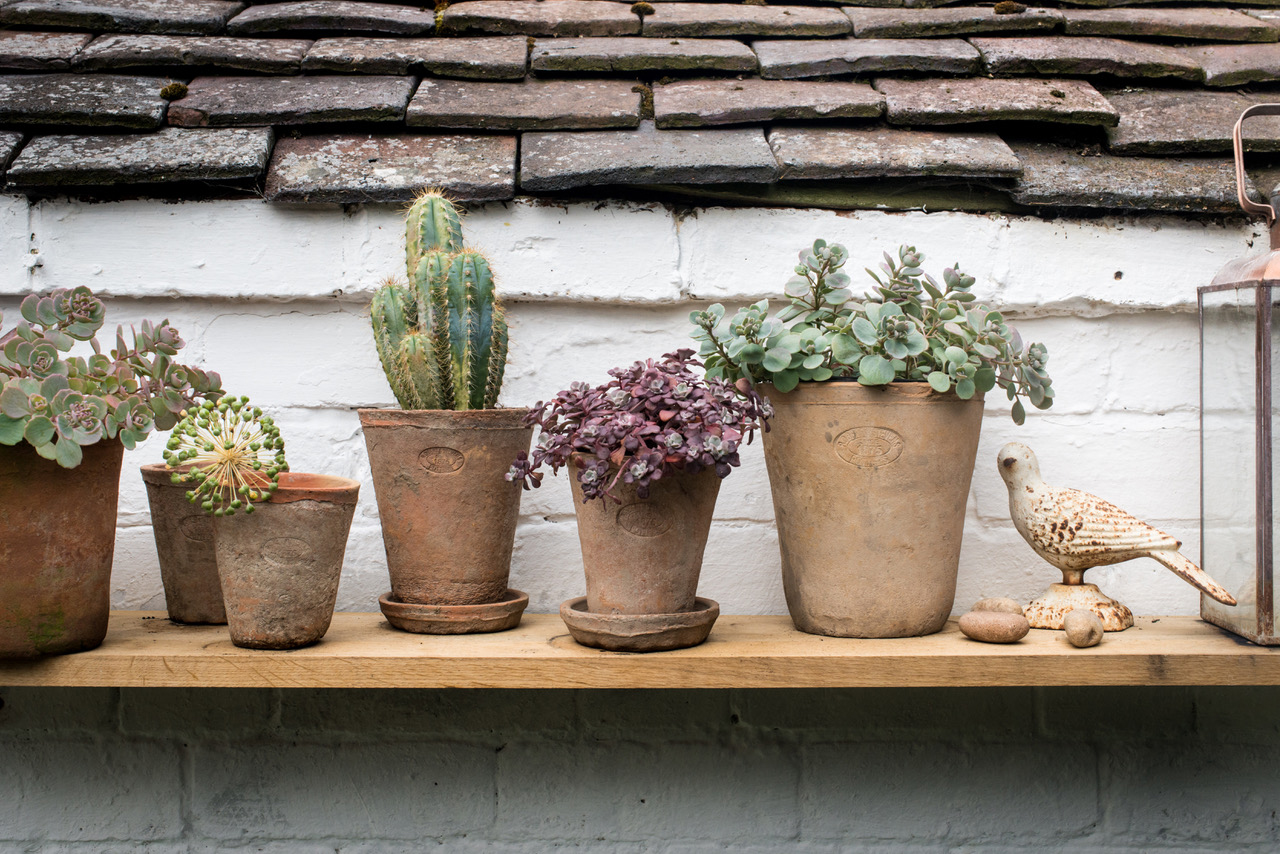
(Image credit: Idyll home)
What are the best plants to put in pots?
Many gardeners use gardening containers, pots and planters for seasonal plants, such as bulbs in spring, colourful bedding in summer, and grasses or foliage plants through autumn and winter. Container gardening allows you to ring the changes year on year, trying out different combinations, alternative colour themes and a range of plant varieties.
We're big fan of container gardening vegetables and herbs in particular. Not only is it of course, deliciously rewarding, but it's also so darn decorative whether you have them growing on a small balcony or in a comically tiny garden space. When the likes of broad beans, courgettes and basil flower for the most part of their season, you get to enjoy the produce and the free garden decor.
Experiment with container gardening. Use pots to assess the success of various plant combinations. Try something new, change it immediately if it does not work, or give it a few weeks and then alter the arrangement if necessary.
- Find all the best garden ideas in our edit.
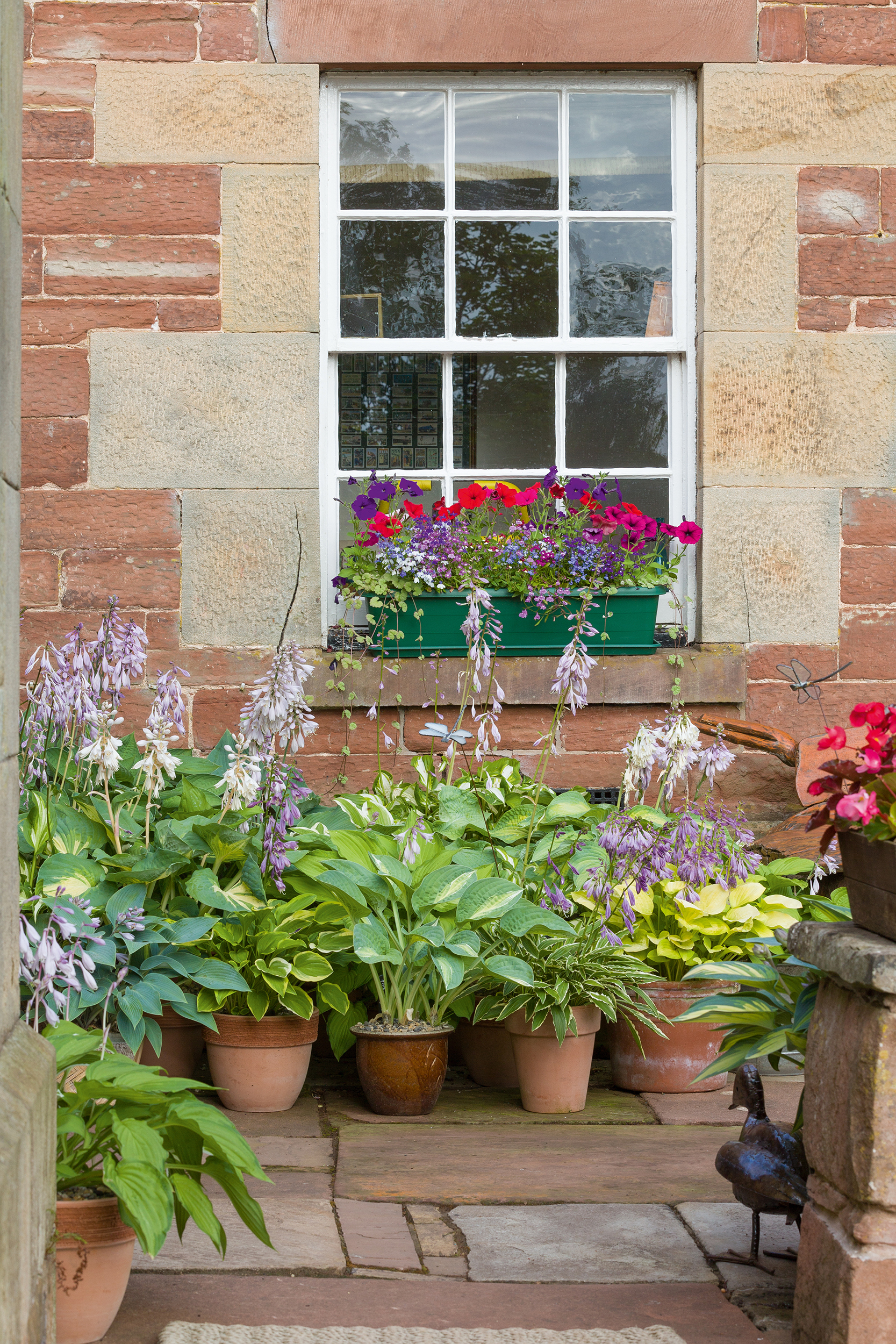
(Image credit: Joe Wainwright)
How to start container gardening
1. Location, location, location
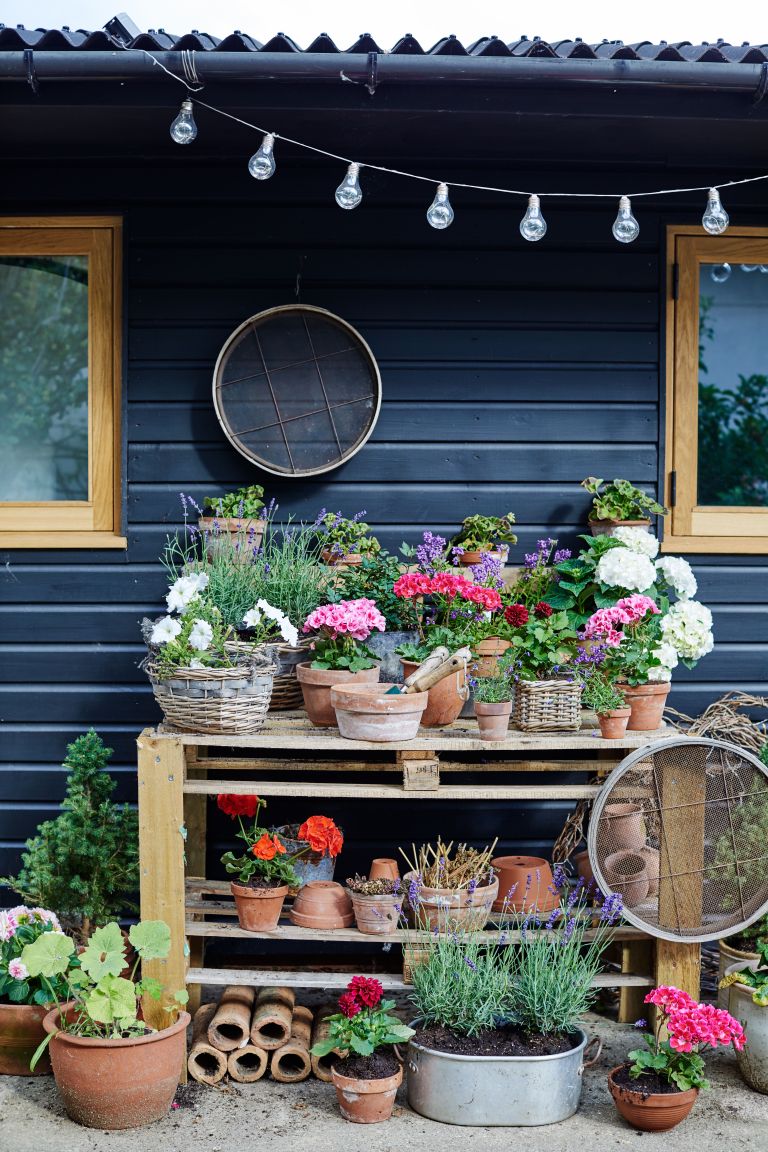
(Image credit: https://www.realhomes.com/completed-projects/real-home-explore-a-restored-17th-century-country-cottage?utm_content=buffer18f4a&utm_medium=social&utm_source=twitter&utm_campaign=buffer&fbclid=IwAR1T6B24zkDilyWEYSBskNQKe0WmjeCYigm5n0pKbqCMJinasCRHEPlr5F8)
Where do you have space or where do you want to make space for your container garden? It's vital to know more or less exactly where you want to see the fruits of your labour so that you can get an understanding of the light levels and protectiveness of the zone. This will help determine the plants you can grow and the pots you need for the best success rate.
South- or west-facing spots will suit plants that need a lot of light – think tomatoes, lettuce, kale, lavender and so on – while a shaded location will be fine to house shade plants like Foxglove, Begonias and Hostas. If you can't find a sheltered spot you'll want to think about choosing hardy plants.
- Pots can make good garden screening ideas if you want privacy in a small spot too.
2. Choosing your container material type
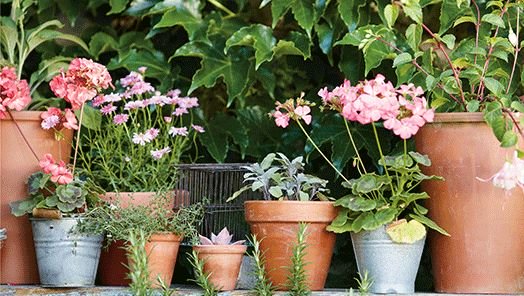
(Image credit: Homebase)
The wide array of garden containers on the market offers something for every size and style of outdoor space. Before you begin wondering what you need for a container garden, think about what you want from it too. This will help with everything from plant selection to picking the best pots and display ideas.
When choosing the best pots for your plants, consider both the plants needs and the finished look that you want to achieve in your space. And, if you're in need of budget garden ideas in particular, that won't mean you'll have to compromise on style at all.
Terracotta, stone and lead imitations of historic models will make life much easier and cheaper, especially if you want to evoke a classical look in your garden or on a terrace. These types of pots are lighter and therefore safer if you are creating displays for a balcony or a roof garden design.
If you want the real deal, it's important to remember that terracotta pots retain moisture which will help stop plants drying out but they are therefore prone to breaking. Keep them in frost-free areas or bring them in during cooler months of the year.
You can also keep costs down by opting for vintage finds for both effortless style and function. All sorts of items can be reused as containers, think old metal buckets, drainage pipes, bulk food containers, oil cans and more. Just remember to drill drainage holes in the bottom of your vessels to ensure your plants don't get waterlogged, check that they were not used to hold harmful chemicals in a previous life and clean them thoroughly with hot water and a little mild dish soap to get rid of any pests or disease possibly remaining from old plants. Something to note with metal is that is will conduct heat very quickly so they are best reserved for shady spots to avoid the roots of your plants getting scorched.
Choosing containers made from rustic materials like wood will give a lovely earthy feel to your space and will keep plant roots at a more consistent temperature also. It's easy to DIY a planter to make this a cheaper choice, and choosing wood that is naturally rot-resistant such as cedar, teak and juniper will prolong the life of these containers.
Polyurethane/plastic containers are functional and cheap. They won't chip or crack and they will protect roots against fluctuations in temperature also, making them a sound and easy choice for beginners. Beautify them with basket-like structures made from woven willow or another natural material.
Finally, if you want a polished and modern looking space, consider containers made from glass fibre, resin, plastic, or wood composite, which imitate natural materials. Note these will be heavier and are usually more expensive but particularly hardwearing.
- Find more garden design tips in our guide too.
3. Selecting the best container shape and size
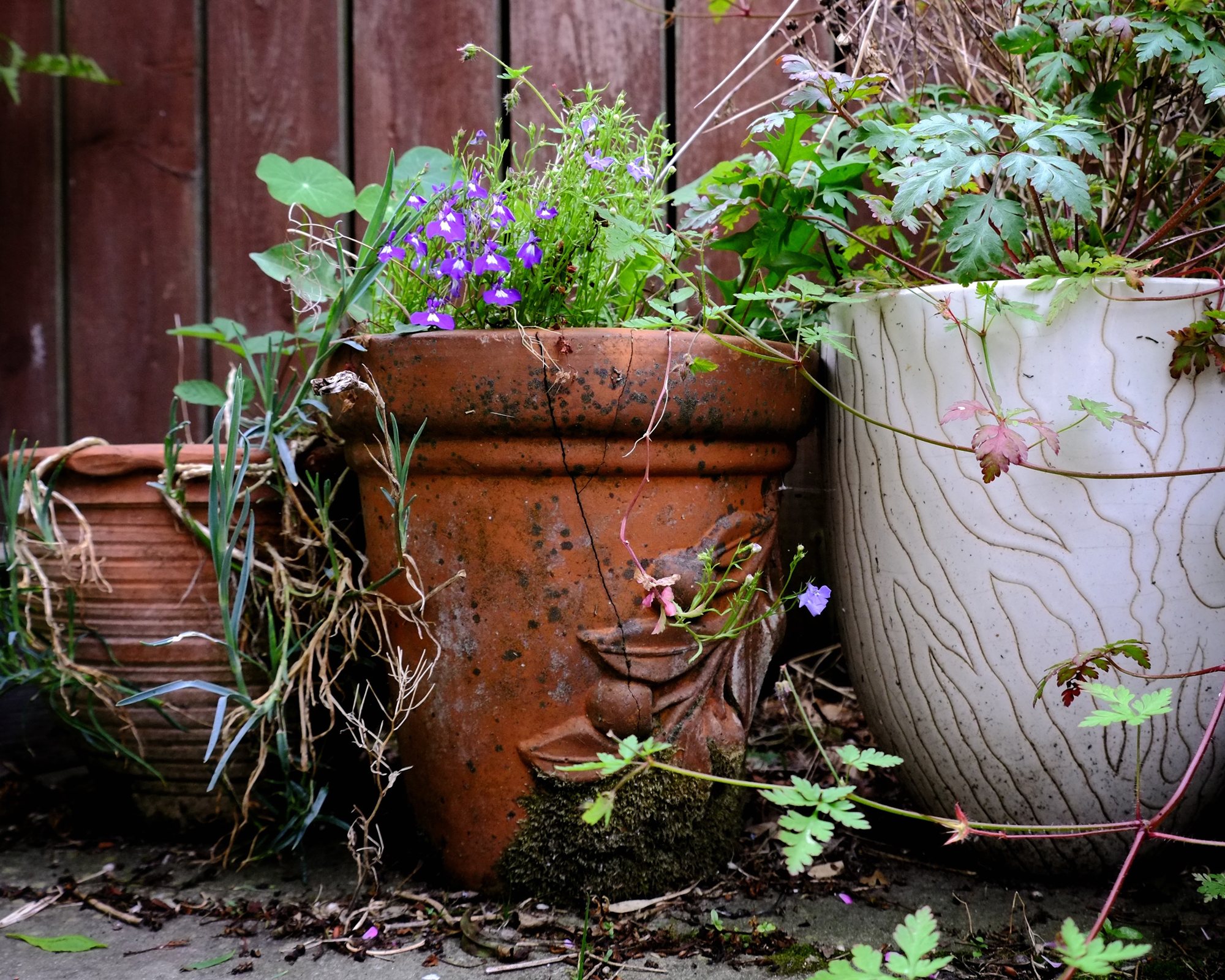
(Image credit: Getty / Catherine Falls Commercial)
The larger the container, the more compost and moisture it will hold, and therefore the less frequently you will have to water it.
Traditional pots, which are wider at the top than the bottom, are perfect for plants, since they provide plenty of space for the roots to grow, and you can remove them easily when you want to re-pot them. A taller pot, which offers even more root room, is vital for some plants and the best choice for many shrubs and climbers, such as roses and clematis.
Plants are more difficult to remove from straight-sided containers, while wall pots with very wide semi-circular tops and narrow bottoms dry out rapidly and are unsuitable for most plants apart from succulents, unless you can water daily in warm or dry weather.
Pots with an incurved top, such as small-necked urns, make it hard to remove established perennial plants without damaging either plants or container; if you like this style, avoid these problems by planting up a small plastic pot that fits snugly into the neck of the urn.
Shallow garden containers that are less than 20cm in height provide a restricted area for rooting and are prone to drying out. They are only suitable for small plants, but can make decorative garden additions if watered frequently.
A very shallow container with a depth of less than 10cm is traditionally used for growing diminutive alpine plants. Many species, such as varieties of dwarf dianthus, flower in spring, so choose those with evergreen foliage, including sedums, phlox, and sempervivum, for a longer season of interest.
4. Choosing the right soil
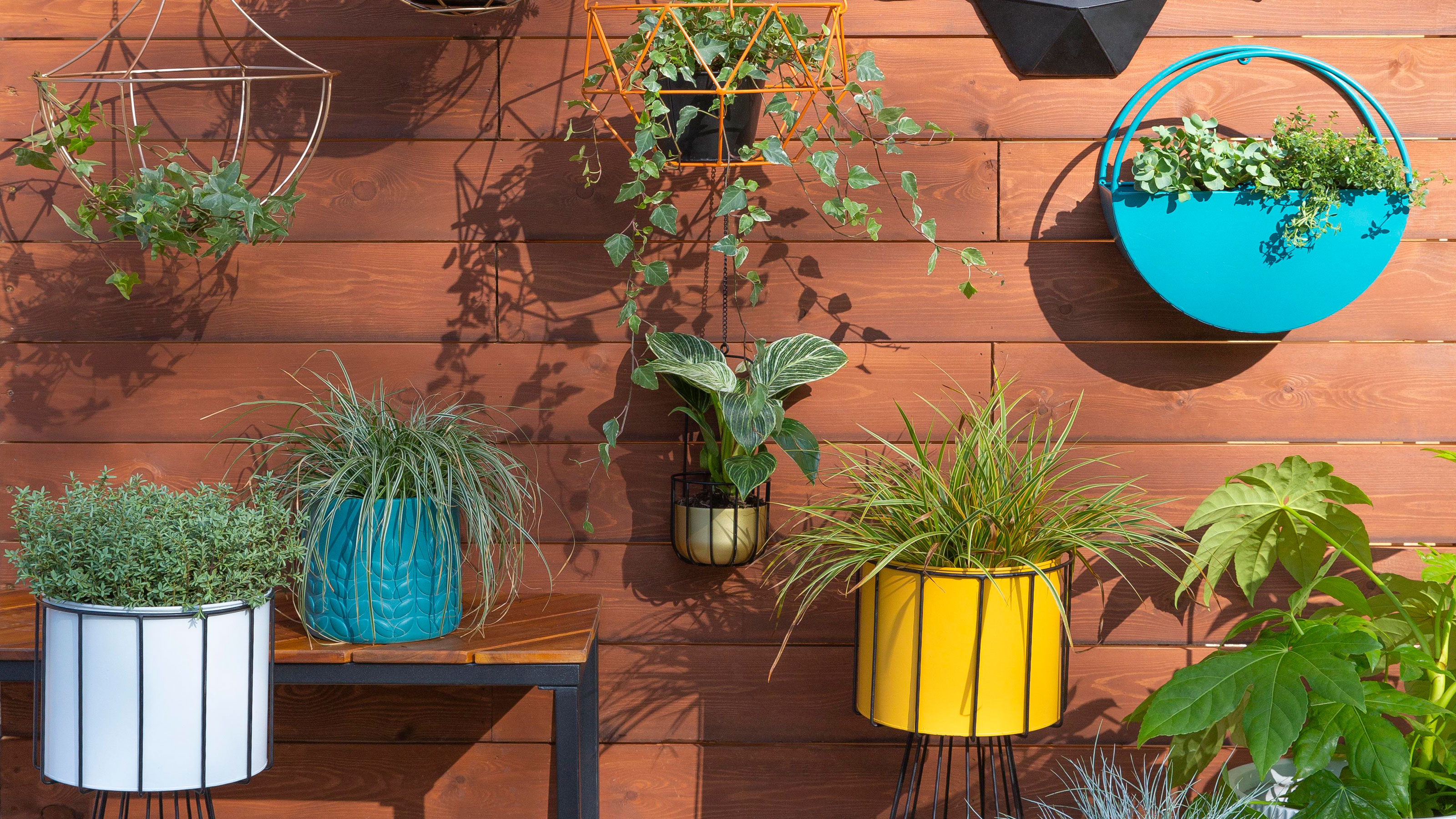
(Image credit: Dunelm)
For the best start with pots, research the plant you're growing in case it has particular needs. Otherwise a multipurpose peat-free compost will suffice to grow most plants.
If you know how to make compost then you're off to a good start. And, if you have a garden available and are container gardening to add interest to a patio or other area of your outdoor space, resist the urge to fill containers with soil from your garden as you'll bring in any weeds which will be a nightmare in the long run.
People often wonder whether to line the bottom of a planter with rocks or gravel, but as long as your soil is lightweight and that there are drainage holes in your pot, you won't need to do this.
5. Choosing the best plants
Choosing plants for your containers is the fun part, whether you're picking contemporary, architectural plants, traditional blooms vegetables or herbs.
Best vegetables for containers
We've had high success rates growing tomatoes, courgettes, broad beans, chillies, peppers, lettuce and more in containers. Size is so important when starting a kitchen garden in pots and never ignore the advice given on seed packets as veggies fighting for room will not be happy.
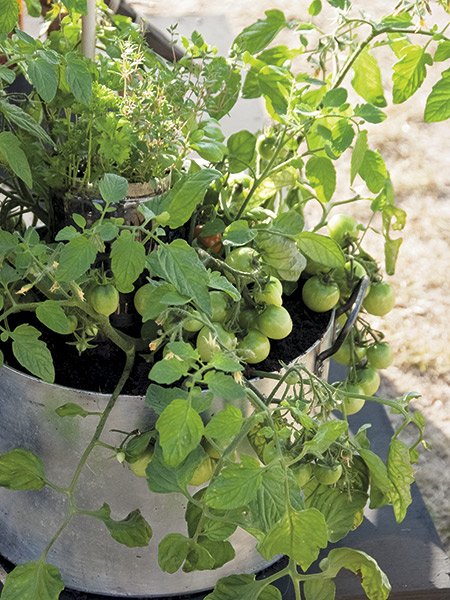
An old saucepan is used here as a home to a tomato plant
Best herbs for container gardening
Herb-wise, mint is a brilliant choice for containers as it will thrive still, all without taking over your entire garden space! Parsley, coriander, sage and basil are also great additions for your herb garden and they do well in pots.
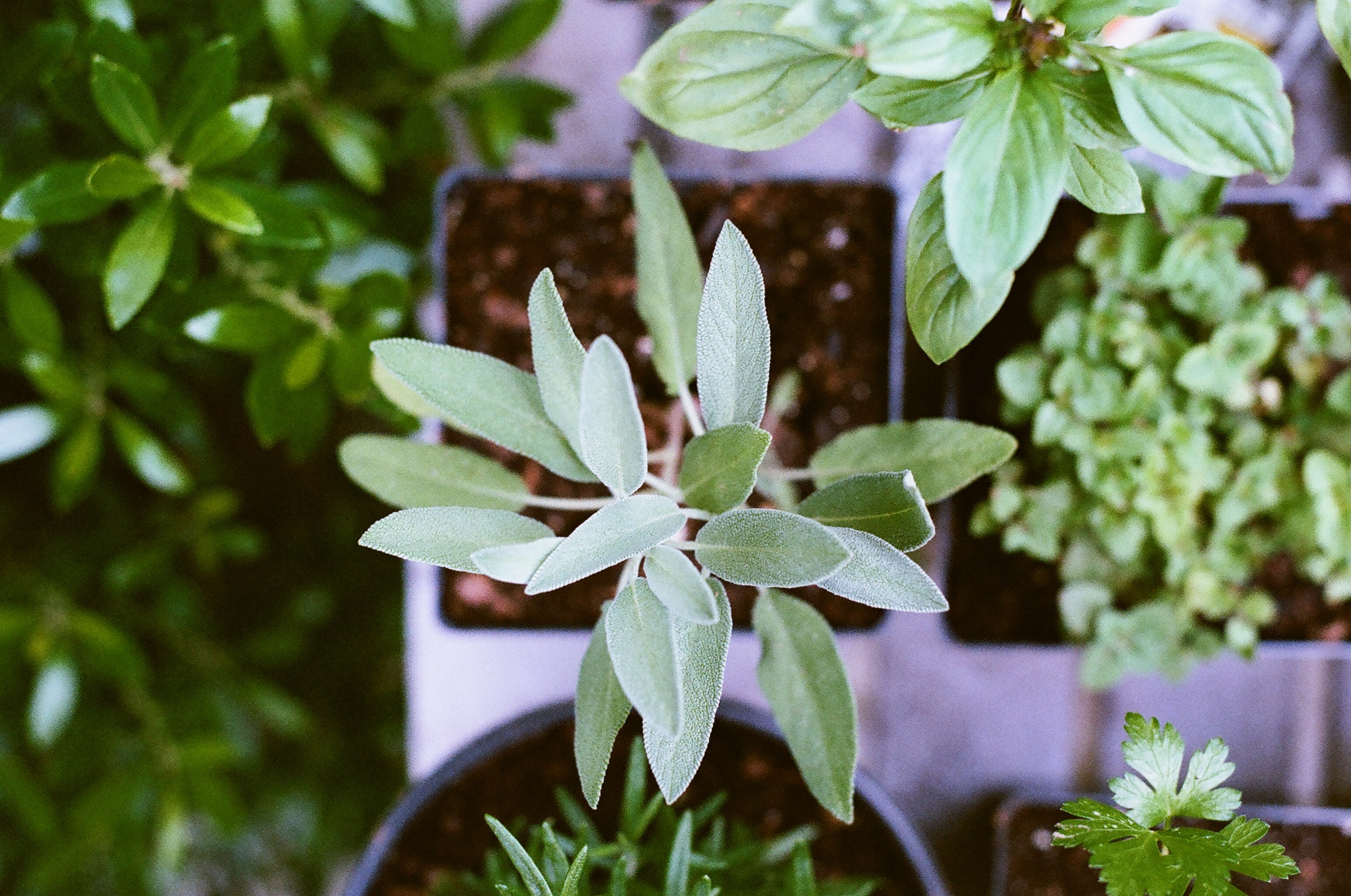
(Image credit: Unsplash/Matt Montgomery )
Best plants for shallow containers
Putting pots on a table top? They're likely to be shallow – so plant up Antennaria dioica, Campanula – dwarf forms, e.g. C. cochlearifolia, Delosperma species, Geranium, Phlox subulata, Rhodiola species, Scleranthus species, Sedum – alpine species, Sempervivum species or Veronica prostrata.
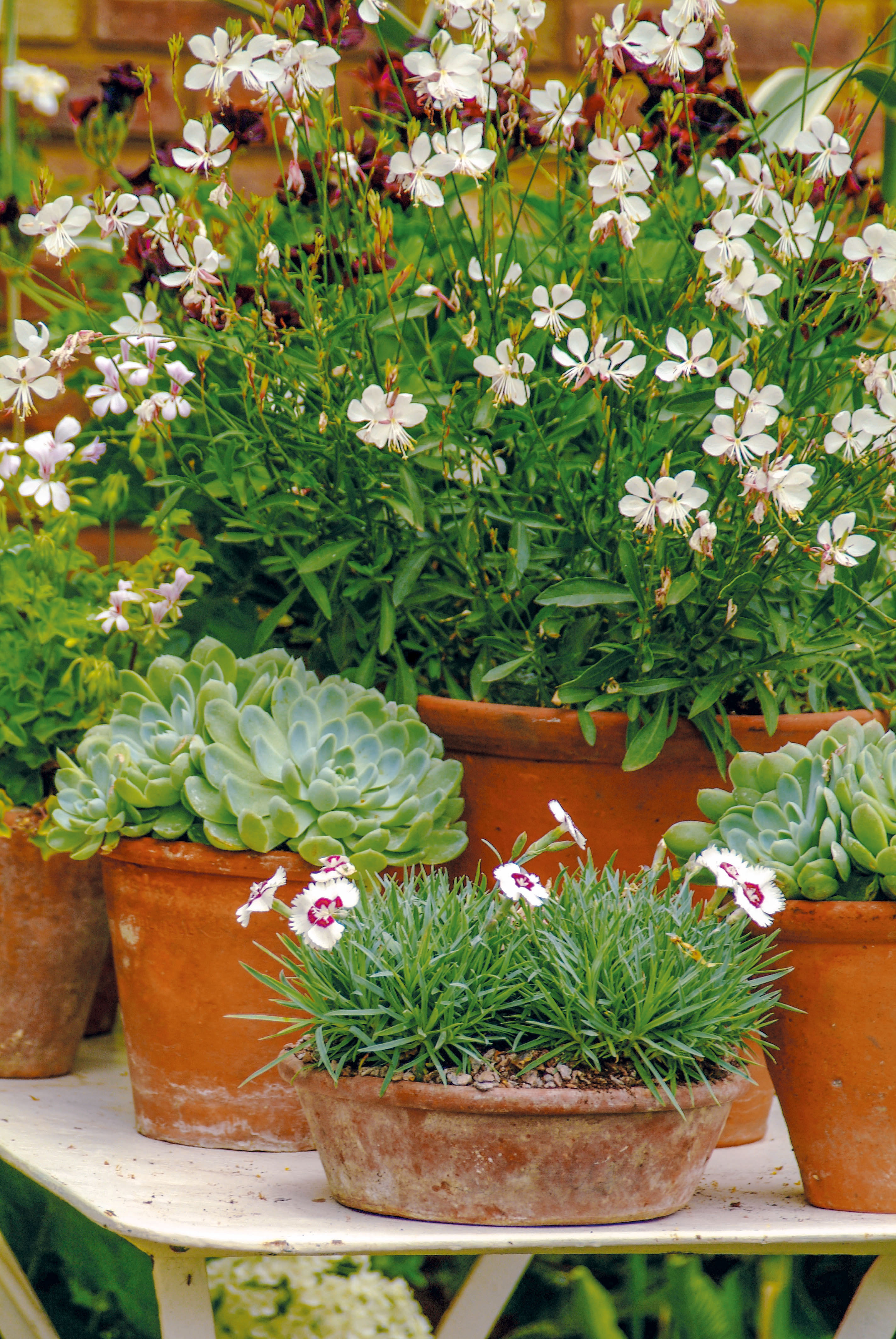
Place taller plants at the back of potted displays and shorter at the front.
(Image credit: @ Frances Lincoln)
Best climbing plants for pots
Climbing plants can be perfect for container gardening. Our best picks are: Clematis – especially small types – Hedera species, Jasminum species and Trachelospermum jasminoides.
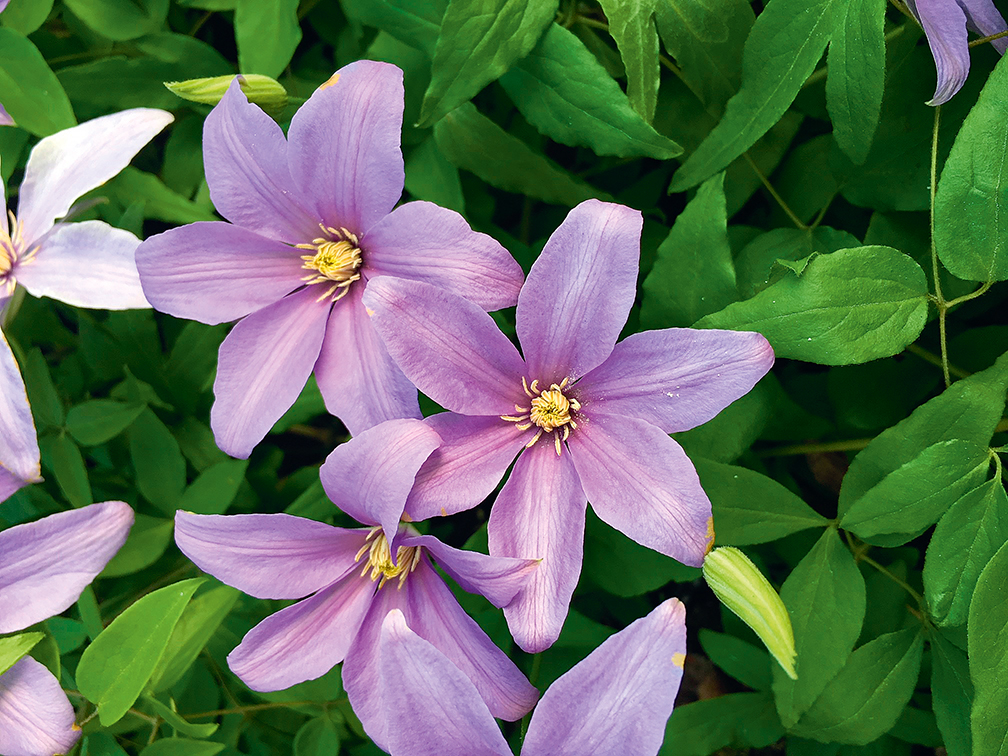
(Image credit: Squire's Garden Centres)
Best perennials for containers
Providing long-term colour and texture, many perennials are perfect for container gardening, but most will need to be lifted and divided after a couple of years. We like Achillea, Bergenia, Ferns, Hosta, Phlox, and Sedum.
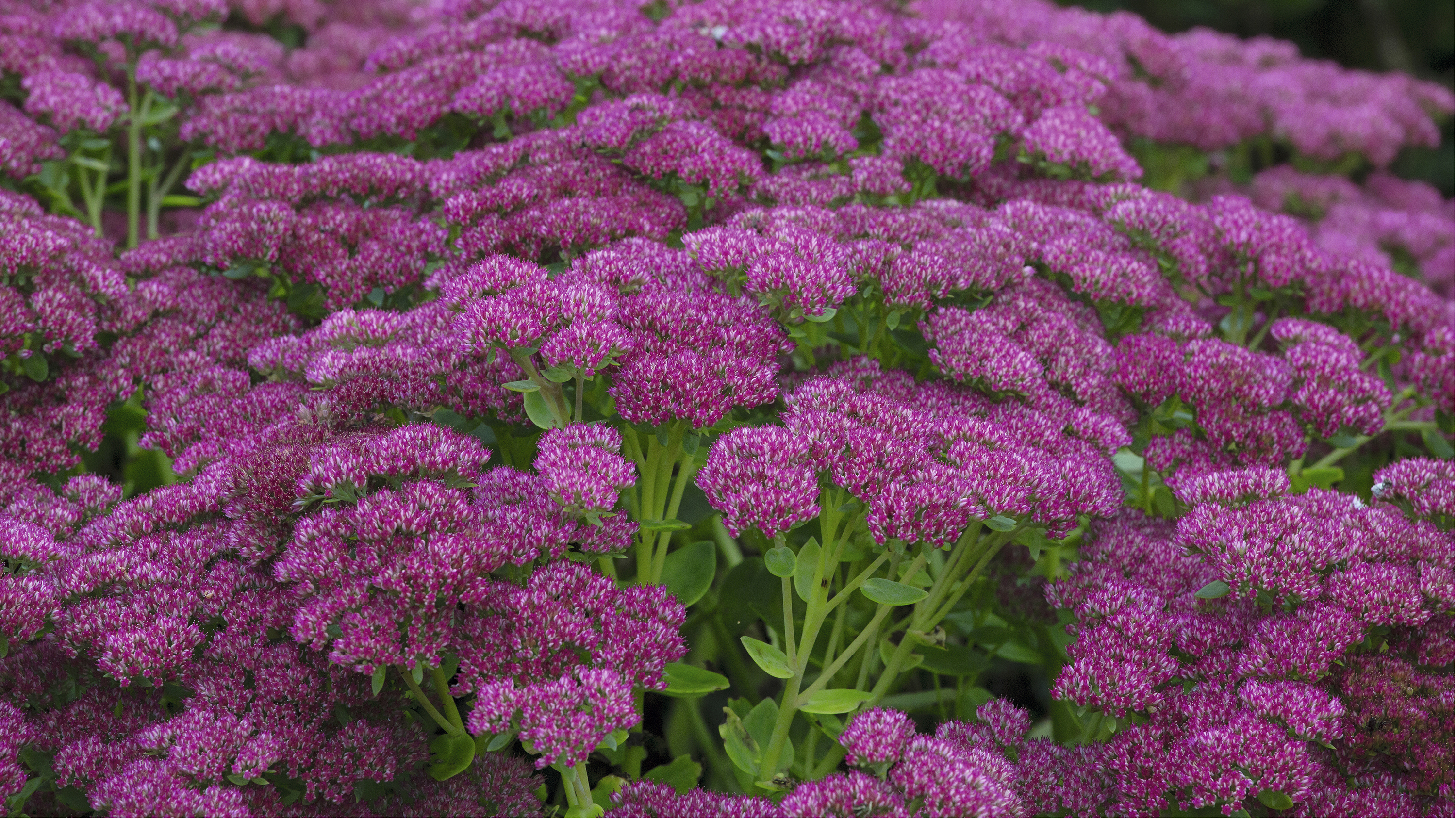
(Image credit: Future)
- See our patio ideas edit.
6. Watering and feeding
Plants in pots have less access to moisture and nutrients as opposed to those in the ground so you need to make up for this, especially in hot weather. Ensure you water them either before sunrise or after sunset (or both if very warm) when it's sunny so that the water soaks through to the roots and to prevent any scorching. When it comes to feeding, many vegetables in particular will benefit from the addition of slow-release fertiliser.
7. More care and maintenance
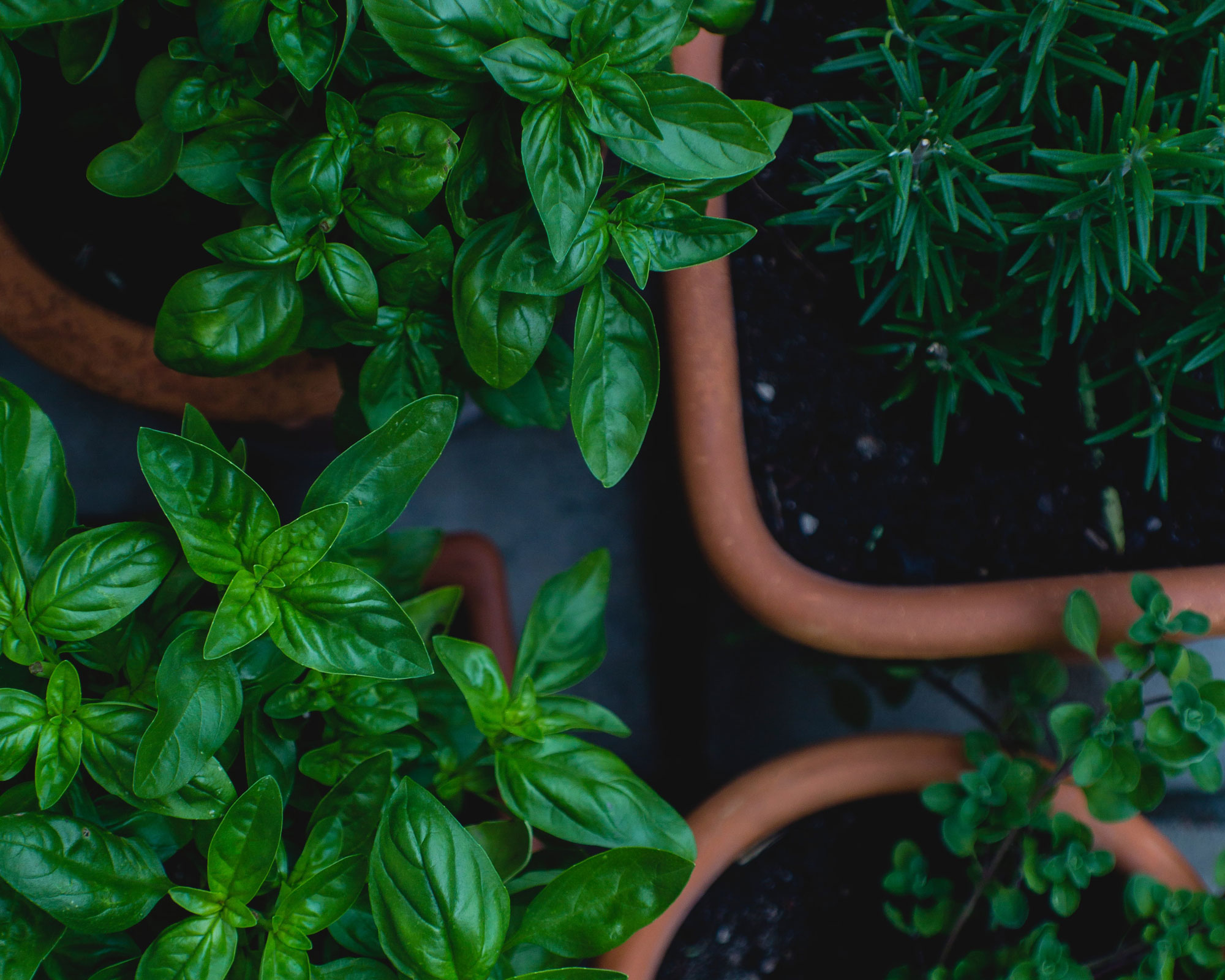
(Image credit: Markus Spiske on Unsplash)
Plants in pots need constant care as their roots cannot extend outwards and reach down to draw on the moisture reserves in the ground; likewise, nutrient levels can quickly become depleted.
Container plants are also far more vulnerable to temperature extremes: in winter the compost will freeze more quickly and more thoroughly than the soil in the ground, and it will also heat up and dry out rapidly during the summer months. The following guidelines will help you to achieve the best results, either by combining separate plants in their own pots, or by bringing together a range in larger containers:
- Tallest at the back, shortest at the front. This is a basic principle for traditional border planting and a good starting point for containers, too. In small spaces it ensures all plants can be seen and the shorter forms hide the sometimes less attractive lower stems of taller ones.
- Rely on mass. Plants fall into one of three basic categories: tall and upright, medium-sized mass, small and spreading. If most of the plants used fall into the middle category, they will give your container combinations weight and physical presence.
- Limit the drama. Don't overdo plants that draw attention to themselves, notably those with height, or dramatic or large leaves. Check that their stems and leaves have sufficient space.
- Pack them in. Seasonal plantings, such as annuals, look best if they are exuberant and fulsome. Closely packed annuals in a container will need regular watering and feeding.
- Less is more. Paring back the number of shapes, shades and species will create a more sophisticated look in a container.
- Remember the little ones. Small spreading plants, including alpines and succulents, also need full sun, so pot them up separately and ensure they are not overshadowed in the container.
Container garden ideas
Your options are fairly endless when it comes to displaying your container garden. These are some of our favourite looks to inspire yours.
1. Enhance basic pots with willow wheels
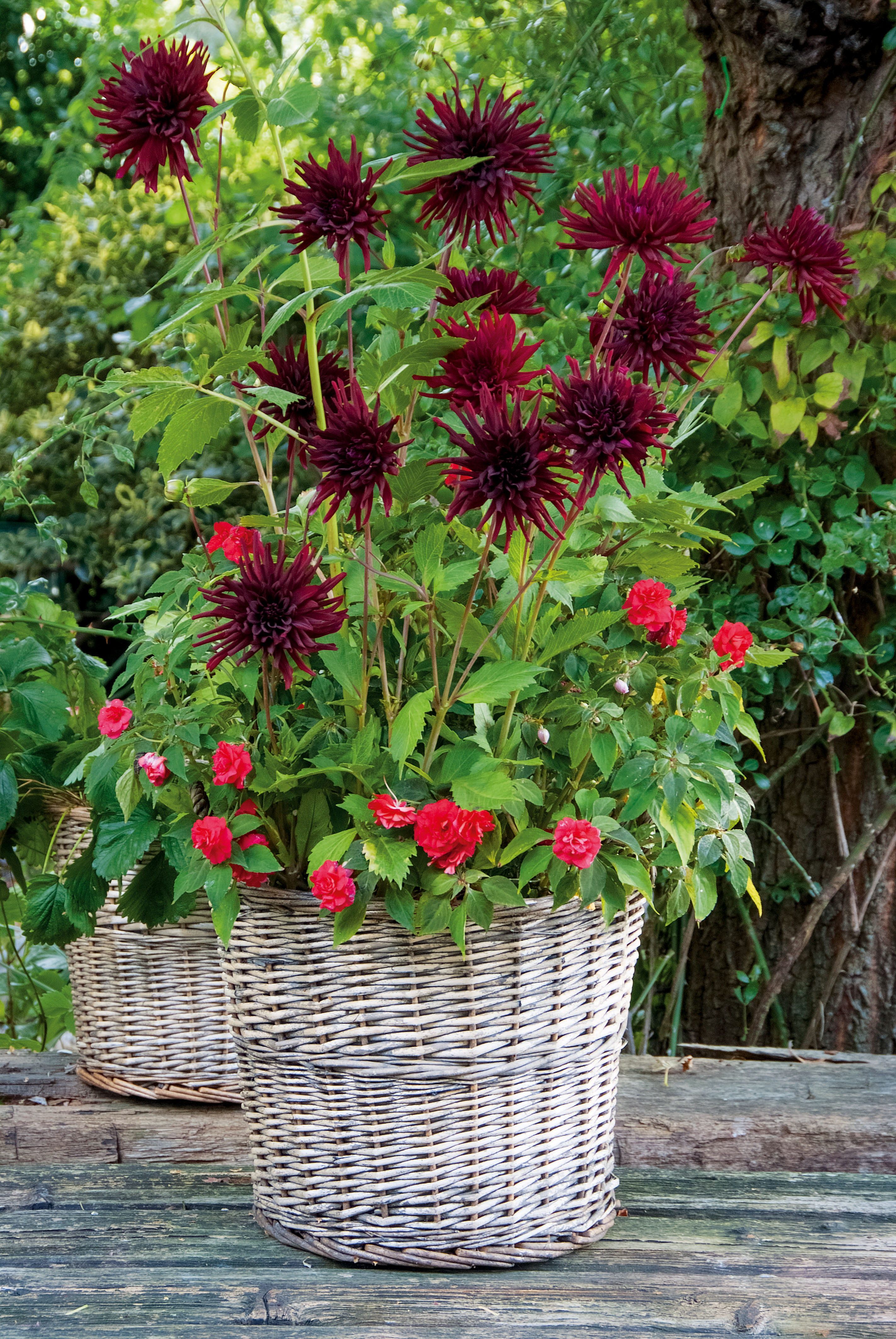
A functional pot housing dahlias is disguised inside this wicker container
(Image credit: @ Frances Lincoln)
Willow can be used to conceal an unattractive or purely functional plastic container, and the life of the willow will also be prolonged because it is not in contact with wet compost.
2. Keep it small and succulent
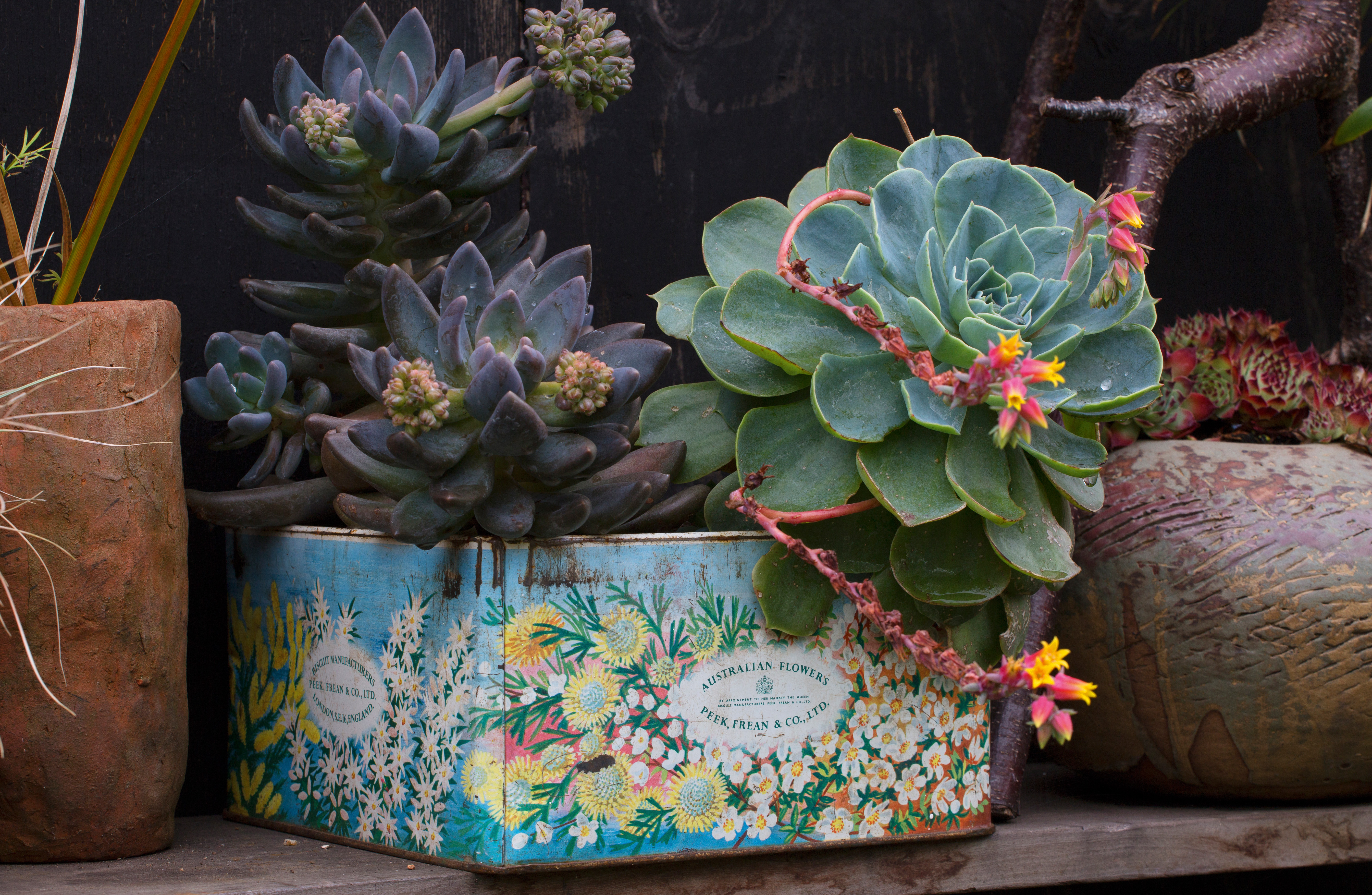
Recycled food cans are used here as a quirky container for plants
(Image credit: Leigh Clapp)
Succulents are super hardy (and cute) so will withstand all the small, odd spots and likely fluctuations in temperature also. They are a failsafe option for all beginner container gardeners.
3. Play with height
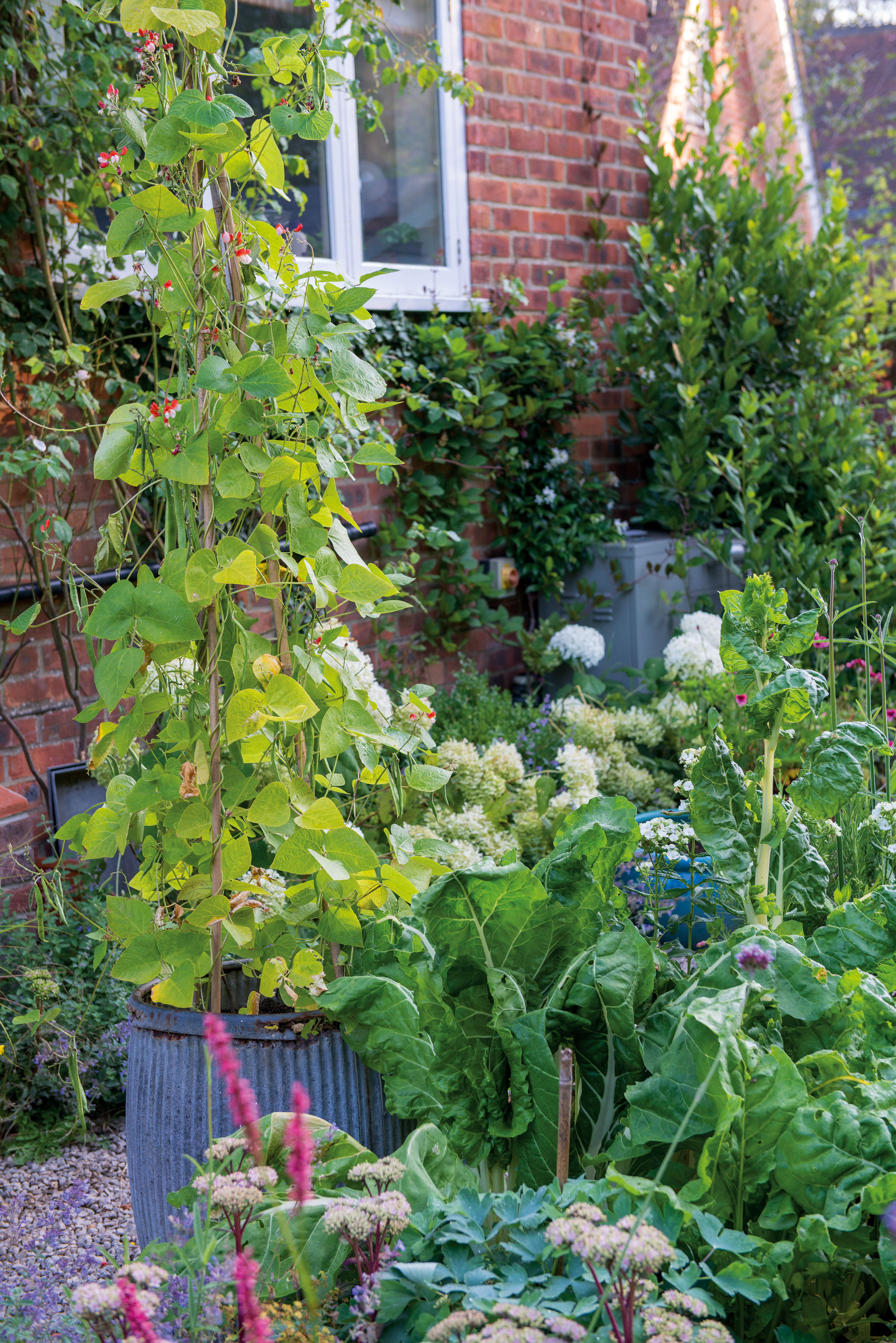
Vintage materials, such as this old waste bin, can be upcycled into plant pots. Drill drainage holes in the bottom to prevent waterlogging, and also stand the pot on 'feet' to raise the container off the ground to prevent blockages
(Image credit: @ Frances Lincoln)
Mixing tall dominating plants in large containers with small plants that are lower to the ground will add interest and enhance the size of a small garden spot too.
4. Hang them high
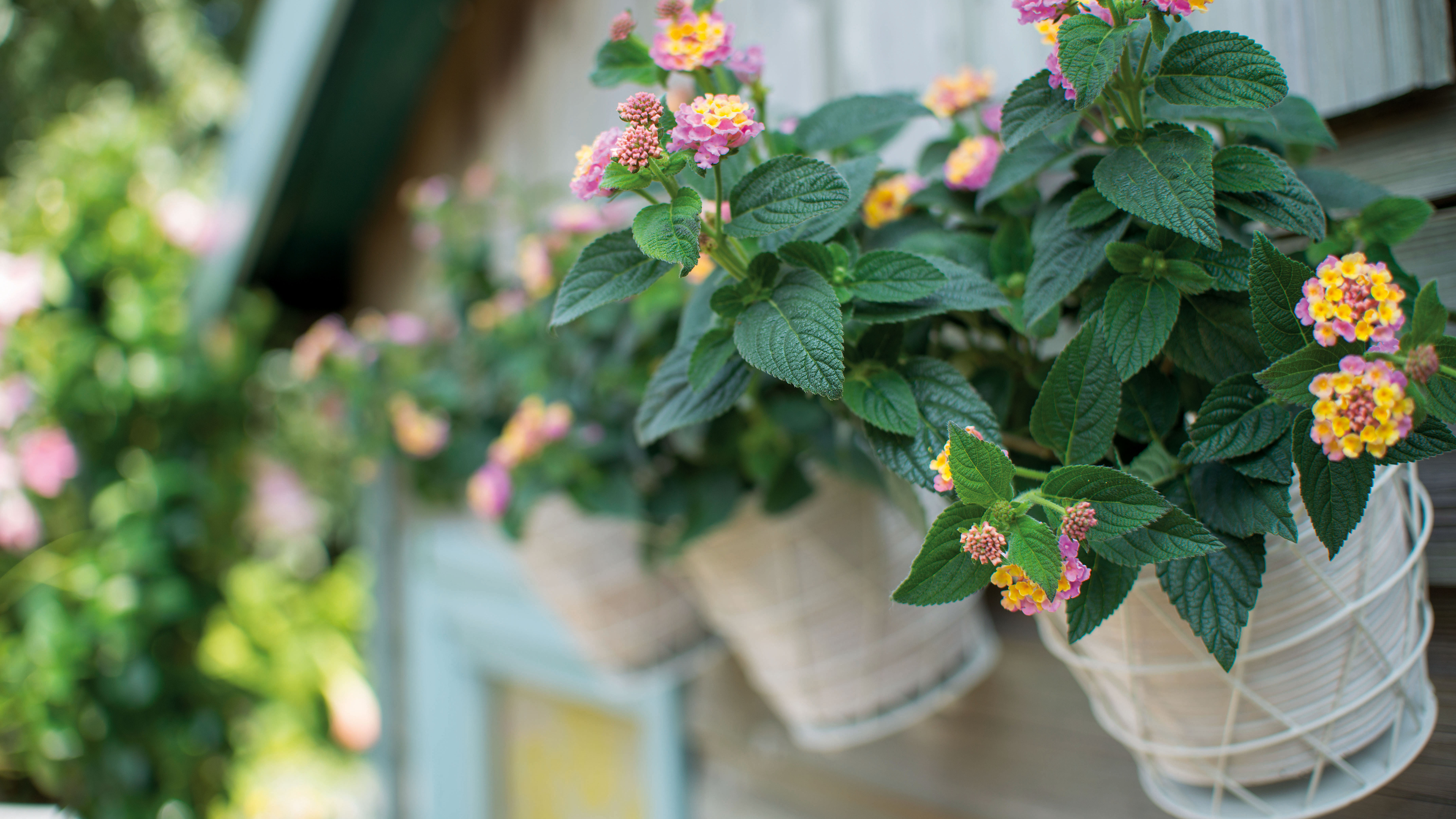
(Image credit: @ Frances Lincoln)
Where space is very limited, a planting display in hanging pots will provide a welcome pop of color to an otherwise plain wall or corner.
5. Stick with terracotta for an earthy feel
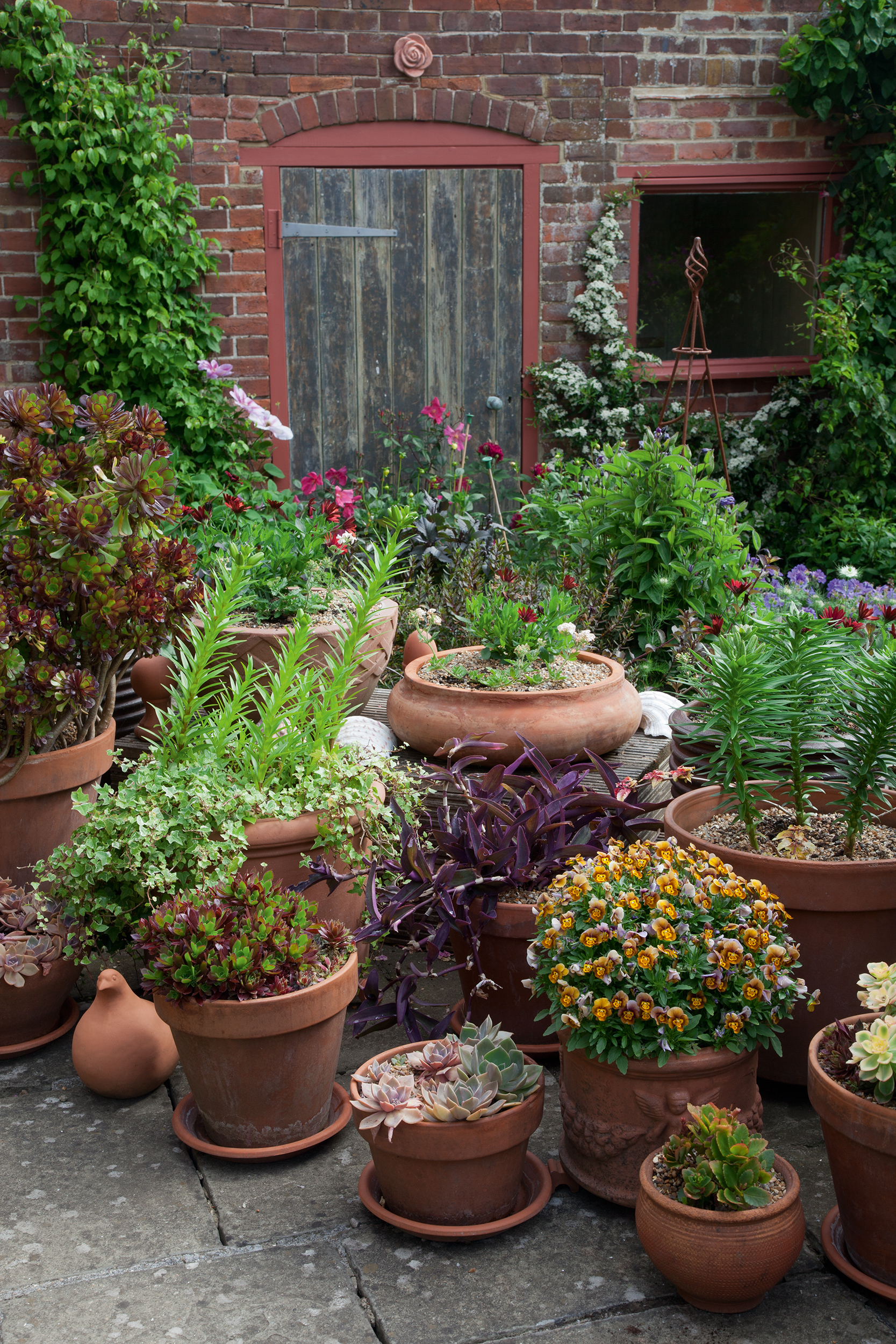
(Image credit: Suzie Gibbons)
A container garden looks so natural with terracotta. Choose different sized containers for added interest and keep any cutesy terracotta accessories close by also.
6. Use container gardening to add punchy colour
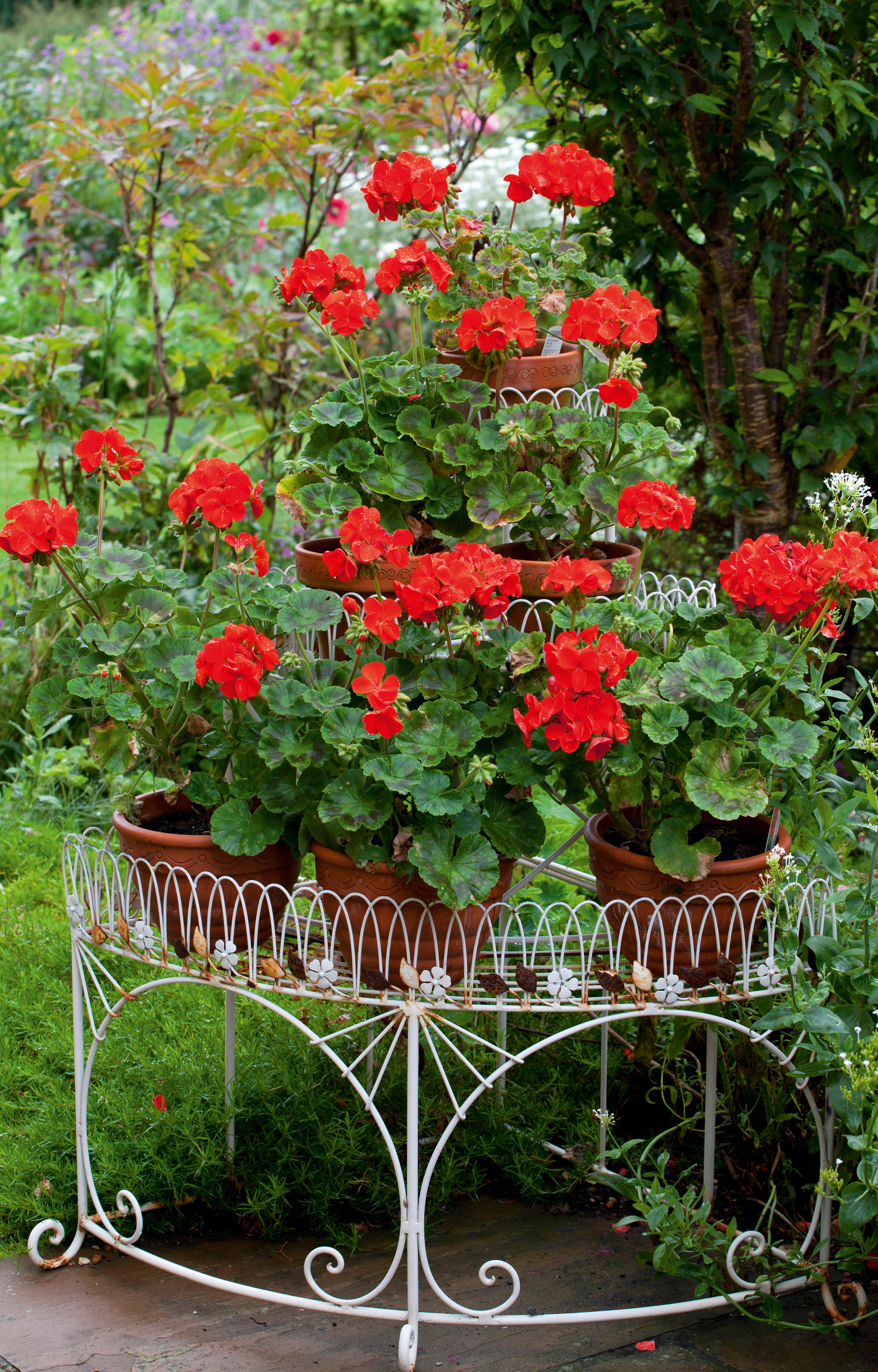
(Image credit: Leigh Clapp Photography)
A garden container planted with just one type of brightly coloured flower can be used to instantly update the colour scheme of your garden. Use seasonal planting to introduce a bit more unusual colour in the spring and summer, or plant flowering perennials for reliable flowering year after year.
- If you need more general advice, find out how to choose plants for your garden in our comprehensive guide.
7. DIY a container garden on your balcony
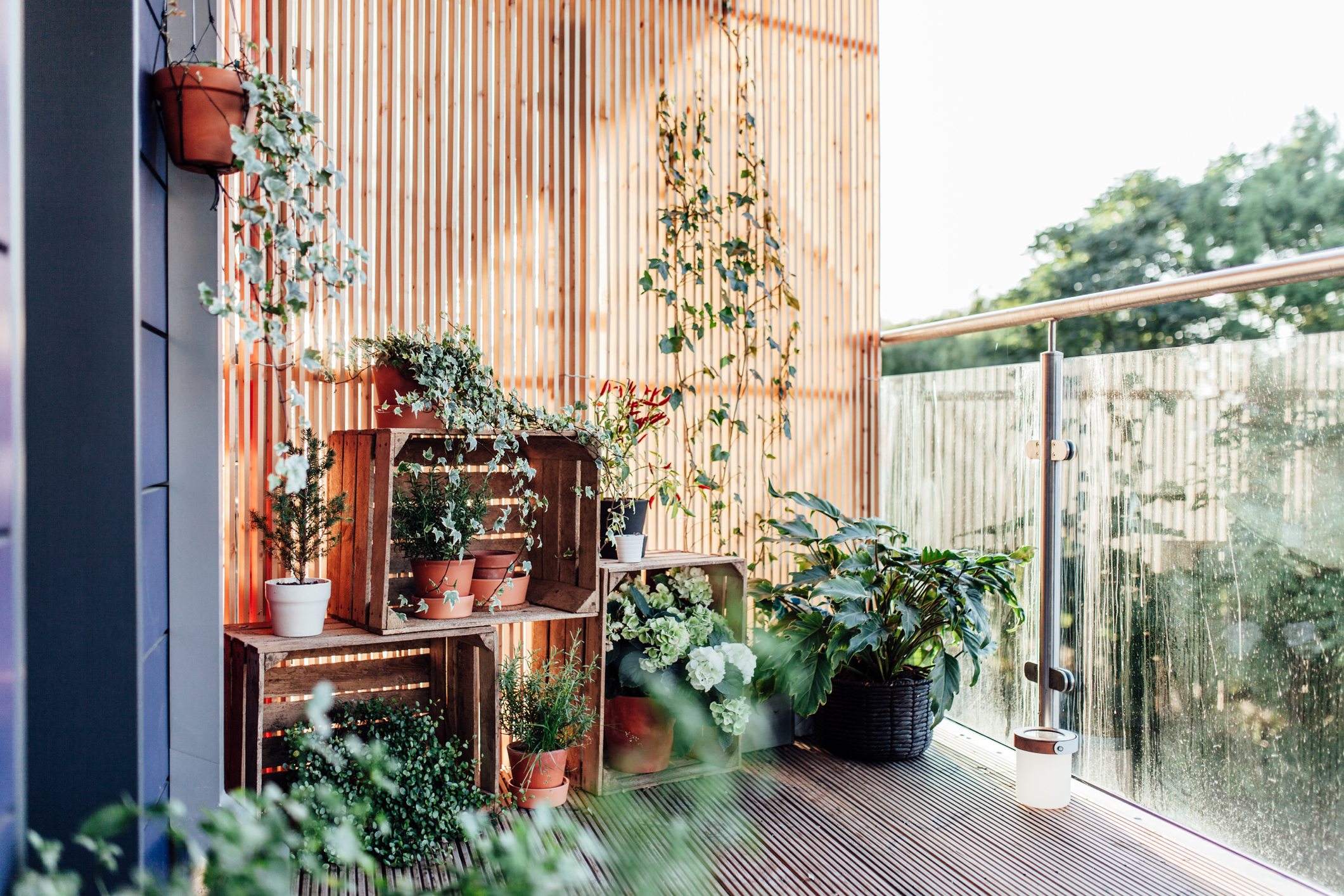
(Image credit: Getty)
If you're starting a container garden on your balcony, you can get away with using a mixture of garden plants and house plants – just remember taking anything non-hardy in when the frosts arrive in winter. Sunny balconies are the perfect spaces for growing pelargoniums and other plants that don't do well in cold weather, because the temperature on a balcony at night will typically be higher than on the ground.
If you balcony is north-facing, you can have great success growing evergreens like ivy in hanging garden containers.
- Tiny balcony? See all our best balcony ideas .
8. Displays containers on tiered shelves
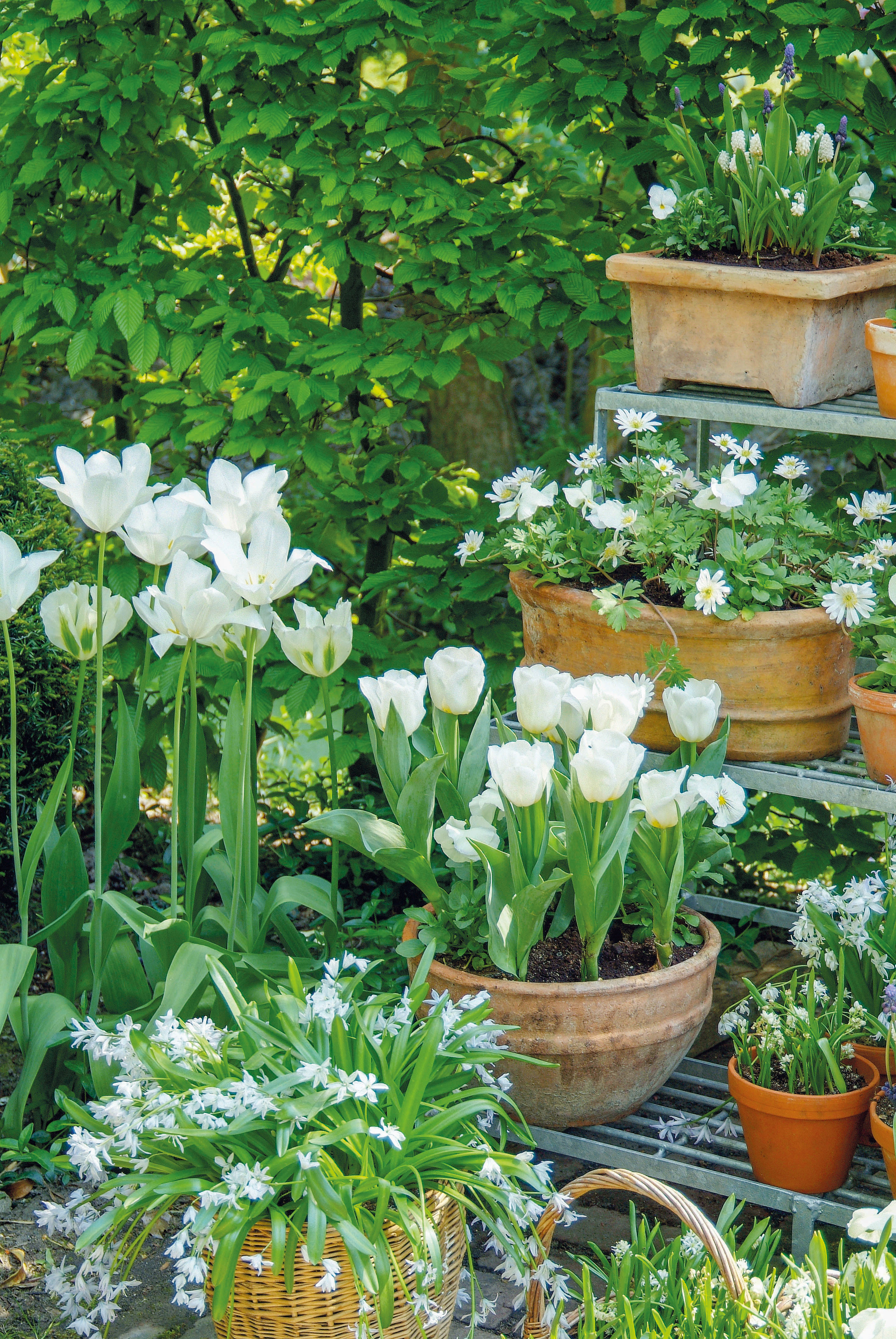
(Image credit: @ Frances Lincoln)
Use shelving so that you can change the display of container plants, bringing those at their flowering peak to the front, or altering the colour combinations to suit the seasons.
9. Or on garden seating
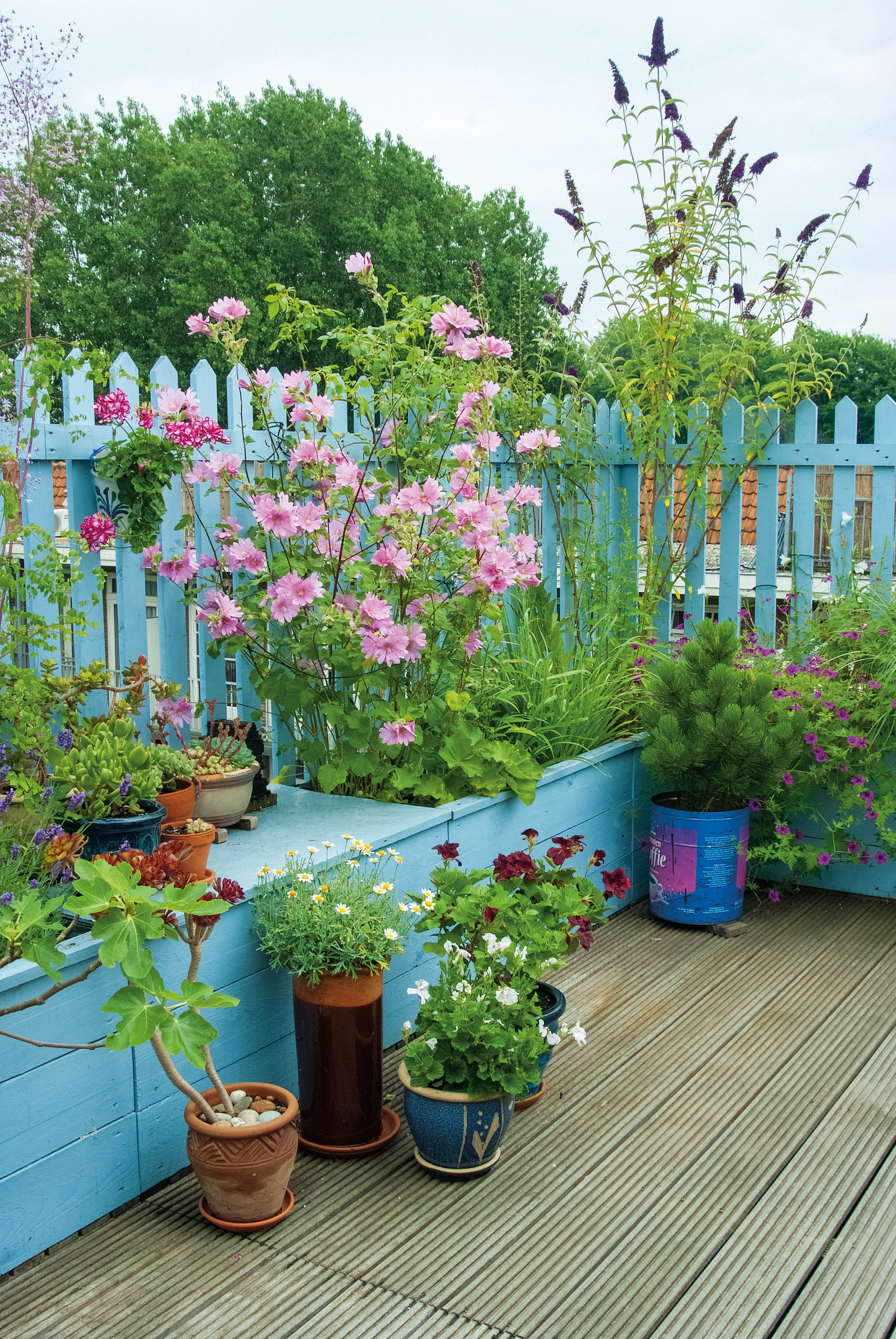
A mix of containers in this tiny garden offers flexibility to swap plants and displays
(Image credit: @ Frances Lincoln)
Using all the levels of your garden will make for an eclectic display, we love combining containers with garden seating ideas to add even more colour and energy to an outdoor space.
10. Mix ornamental plants for texture
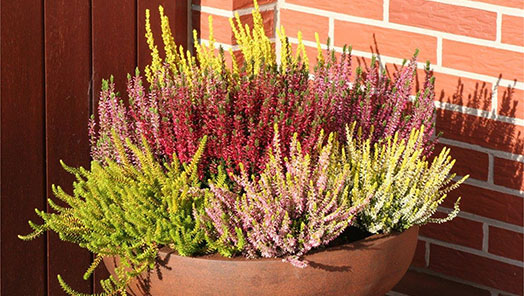
(Image credit: Homebase)
Add texture to even a small corner of your outdoor space with bushy heather and alpine plants for a little contrast but lots of volume.
Photographs: Maayke de Ridder
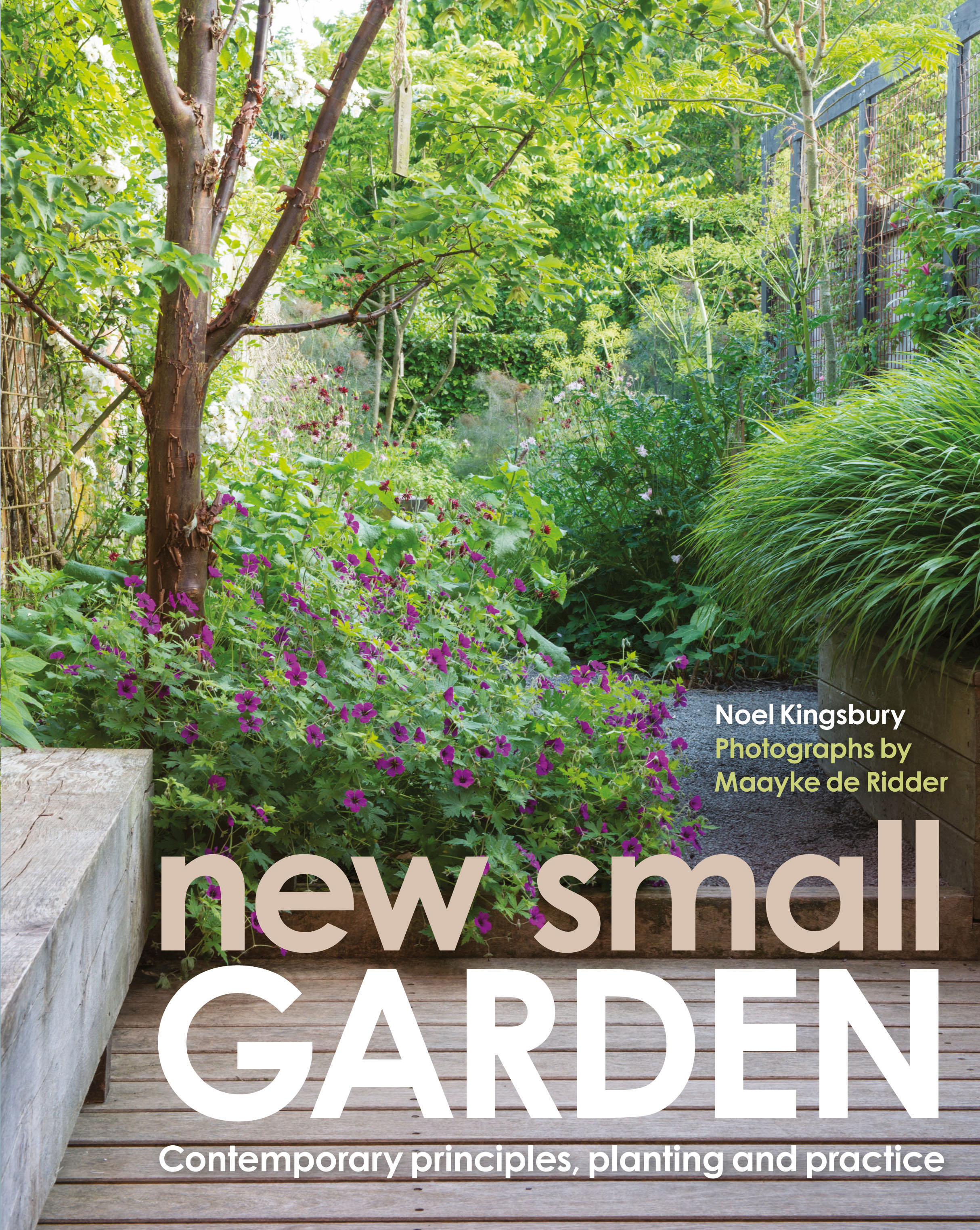
This is an edited extract from New Small Garden by Noel Kingsbury, with photographs by Maayke de Ridder (£20, Frances Lincoln)
(Image credit: @ Frances Lincoln)
We told you you could container garden it like a pro.
Container Gardening In Small Spaces
Source: https://www.realhomes.com/advice/container-gardening-for-small-spaces
Posted by: jensonexpeater.blogspot.com

0 Response to "Container Gardening In Small Spaces"
Post a Comment